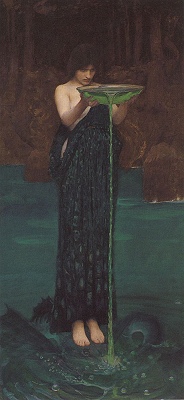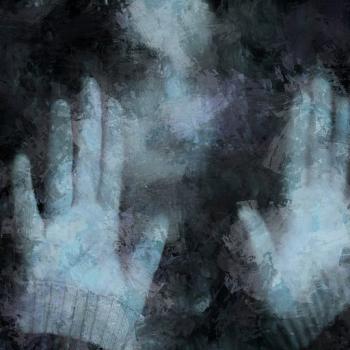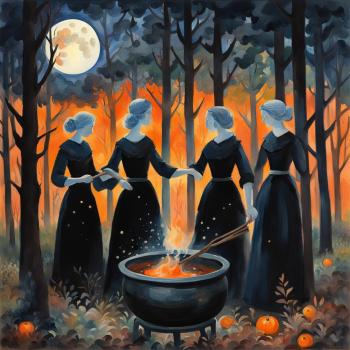 A big issue facing teachers is presentation. How do we know that we are making it through to our students? If we are responsible Guides, we want to give them the best possible opportunity to develop and grow. One of the best ways in which we can do this is to realize that since everyone learns differently, the more of our senses we bring to bear in a given lesson or ritual, the more likely we are to present something in a way that everyone understands and connects with. Also, presenting information in different ways makes it inclusive, even to those with disabilities. Here are some suggestions as to how to make this work:
A big issue facing teachers is presentation. How do we know that we are making it through to our students? If we are responsible Guides, we want to give them the best possible opportunity to develop and grow. One of the best ways in which we can do this is to realize that since everyone learns differently, the more of our senses we bring to bear in a given lesson or ritual, the more likely we are to present something in a way that everyone understands and connects with. Also, presenting information in different ways makes it inclusive, even to those with disabilities. Here are some suggestions as to how to make this work:
Sight: The Eyes Have It
Humans are (usually) primarily visual creatures. We have eyes on the front of our heads and we see both color and movement very well. So be sure to include a lot of visual elements in your presentation or ritual. Some ideas:
Lessons
Rather than presenting a boring lecture, be sure to jazz it up a little. If you’re explaining what ritual tools are for, show your students some ritual tools. If you’re telling them how to set up an altar, draw a diagram, or maybe take a picture of your own as an example. I’ve said this before but I’ll say it again: just because it’s Paganism doesn’t mean that you can’t draw upon time-honored tools of the teaching and presentation trade. Use diagrams, chalkboards, Power Point, posters, notes, murals and mind maps. Create graphs and charts where applicable. If possible, use video; I find this an incredibly effective tool in my own instruction and I find that people respond well to it. Lately, Pintrest is being used by respected Pagan writers as a way to draw attention to catch phrases or key concepts. Give people something neat to look at and it will get their attention!
Rituals
The visual elements inherent in a ritual are already powerful. If you want to improve on them, don’t be afraid to add a touch of the theatric! Why not use costumes? Dances? Dry ice fog for the Samhain ritual? Key symbols and colors are also good for triggering responses that make a ritual “stick,” which is magickal training involves memorizing correspondence tables. You might be able to say a lot more with the symbol of the planet Mercury than you can by trying to describe a spell for safe travel. This is also why icons and idols are used to communicate with the Divine; it helps us to make that connection if we have a visual cue.
Hearing: Lend Me Your Ears
We are creatures who value verbal communication and this is the most common method of exchanging information for our species, so making use of auditory elements usually isn’t hard. Suggestions:
Lessons
You know you’re going to spend much of the lesson talking, so break it up and change it up a little. If any auditory element goes on long enough, we learn to tune it out. Co-instruct so you can change off when people start looking glassy, bring in guest speakers when possible, or run videos that illustrate what you’re trying to say. You can use guided meditations, which you can make yourself by simply choosing appropriate music and reading one, or recording your voice over music onto an mp3 so that you can do the meditation too. And don’t neglect the effectiveness of music as a learning tool, as I discussed in my last article.
Rituals
Most rituals include chanting and poetic ritual invocations, and these are effective. If you want to go a step beyond, get some participatory drum circles or chant sessions going, or even use theme and mood music in your theatrical presentation.
Touch & Movement: A Hands-On Experience
Some people need to touch and feel real results. They need to get their bodies involved. This element is often neglected in both instruction and ritual.
Lessons
I find the best way to introduce this element is to get people doing things. If I am teaching about how to inscribe magickal candles, I have my students inscribe candles. If I am instructing in the ritual format of my tradition, I have my students take turns calling the quarters. In the previous example of the ritual tools, I pass mine around and let my students experience them (I can always cleanse them later.) My students set up the altar first and then I change what I need to afterwards. Encourage students to do it themselves as much as possible; you will empower them and make them more confident when it’s time for them to take the reins on their own.
Rituals
This can be difficult because needs will vary depending upon number of people involved. Also, you will often (assume usually) have someone involved who is disabled. Again, have people do things. But I also stand by the use of dance. Dance is fun, it raises energy, and it gets people involved. For those not up dancing, ask them to do what they can (for instance, the hand movements but not the leg movements) or get them to drum, or chant, or shake rattles. Whenever possible, put those with mobility challenges in the middle of your circle while you’re doing this. Everyone is included then, rather than lurking on the outside, and even a full quadriplegic will feel the power and the energy being raised in this way. If you do nothing else, I encourage you to at least provide a point in the ritual in which everyone joins hands; it helps build connection and unity.
Taste & Smell: A Rose by Any Other Name
Because these are subtle senses, we don’t often give them much thought. But using these senses will give your students a tool that will instantly trigger their memories of the information you shared, without any effort at all on their part. Consider it. What comes to your mind when I mention apple pie? How about the scent of rain in the spring? Powerful stuff, and little used. Give the gift of memory!
Lessons
Subtle elements are best used in subtle ways. Light an incense stick when you’re doing the guided meditation. Make the associations appropriate; perhaps myrrh for Underworld journeys or ylang ylang for encounters with the Moon Goddess. Always smudge before each class; sage improves memory and learning, and since smudging is so widely used in North American Paganism, you’ll trigger your student’s memory through the association every time she or he goes to a circle afterwards. Try to have lessons outdoors when possible, or if you have a dedicated area, use the same one every time, and eventually the scents of the place will linger in your charges’ memories and as soon as they walk in, they will achieve the proper frame of mind without effort. And have you ever noticed how often conferences have coffee and little snacks available, and how often religious groups have a potluck social after the worship service? The reason for this is more than giving people an excuse to chat together, although that is part of it.
Rituals
Most Pagan rituals already include elements of this but it’s just something to keep in mind. Most Wiccan rituals involve anointing oils or incense; sumbel involves drinking; many Pagan rituals have a “cakes and ale” portion in which food and drink is shared. The physical “grounding” helps the knowledge to stick. To go a step beyond, use tastes and scents appropriate to your theme, such as serving harvest fruits for Mabon, or perhaps pomegranates at a ritual to Persephone.
A word of caution: some people have serious allergies to foods or scents. Of course if you’re aware of the specifics for individual group members, avoid these things. But you can minimize potential of triggering responses when you’re not sure by using only natural scents, because allergies to these are much less common than allergies to artificial scents, especially strong ones. You can assure that your ritual food is vegan-friendly and gluten, lactose and nut-free by serving fresh fruit. Non-alcoholic sparkling juices or natural fruit juices usually cover that element in the drink portion (and some people are really against alcohol, so unless tradition really demands it avoid it at public rituals.) A tip: frankincense makes excellent “default” incense because it is used to treat asthma and is therefore unlikely to trigger asthmatic responses, but make sure you get the natural stuff and not the perfumed dollar store variety.

The Sixth Sense: Intuition
Well, we do generally believe in magick and psychic ability and we want people to put that to work, don’t we? Here’s how you get the sixth sense involved:
Lessons
You have to deliberately create a space for this in a lesson, but since this is one of the skills we are teaching, I think it’s worth the effort. Have your students keep dream diaries and practice lucid dreaming. Get them to practice scrying, psychometry, automatic writing, Drawing Down, or anything that induces a mystical trance. Guided meditations are some of the best ways to train the trance state necessary for intuitive sensing, especially for beginners. Use lots of them. Use them often. Use Zener cards or regular playing cards to practice ESP. Teach healing arts.
Rituals
Most rituals at least include a portion in which magick is used and directed towards a purpose, and that makes use of the sixth sense as much as anything else, but I encourage you to try to involve other exercises. Have your participants scry for each other, or do a group reading of a runecast. Do a group grounding exercise. Take turns Aspecting the Goddess in the circle. It’s only limited by your imagination!
As a final note, don’t be opposed to the experience of personal gnosis, either. If your students tell you they’ve been visited by Hecate who taught them a new insight, how do you know they haven’t been?
Don’t forget, the more senses you involve in an experience, the better you retain it, so try to include all of these elements each and every time, and soon you will develop a reputation as a gifted Guide to your Seekers!
Next column: Obstacles to Learning.
Seekers and Guides is published on alternate Mondays. Follow it via RSS or e-mail!

















